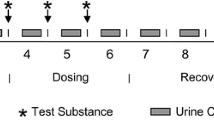Abstract
Styrene is stereoselectively oxidized by cytochrome P450 to its reactive metabolite, styrene oxide. The (R)- and (S)-enantiomers of styrene oxide can be conjugated with glutathione (GSH) to both (R)- and (S)-diastereoisomers of the specific mercapturic acids, N-acetyl-S-(1-phenyl-2-hydroxyethyl)-L-cysteine (M1) and N-acetyl-S-(2-phenyl-2-hydroxyethyl)-L-cysteine (M2). Several investigations have indicated different toxic potential of the (R)- and (S)-configurations of styrene oxide and its GSH- and N-acetyl-conjugates. In this study the mercapturic acid diastereoisomers were measured in the urine of rats exposed to styrene in combination with ethanol, a good inducer of styrene metabolism. Male Sprague-Dawley rats were given an isocaloric liquid diet containing ethanol (5% w/v) for 3 weeks. Starting from the 2nd week, the animals were also exposed to styrene vapours (300 ppm, 6 h/day, 5 days/week) in a dynamic exposure chamber. Both the (R)- and (S)-diastereoisomers of the M1 and M2 as well as the conventional biomarkers, mandelic acid (MA) and phenylglyoxylic acid (PGA) were measured in urinary samples. Approximately 30 and 25% reduction of the levels of brain non-protein sulfhydryls (NPS) was observed in the animals given styrene and ethanol, respectively, while the combined ethanol and styrene treatment resulted in a 60% decrease. Ethanol consumption also resulted in higher urinary levels of the M1-R, M1-S and M2 metabolites associated with increased M1-R/S ratio and higher urinary MA excretion compared to animals treated with styrene. These results suggest that the urinary mercapturic acid diastereoisomers may be used as a noninvasive tool to examine stereoselective patterns of styrene metabolism in vivo, as well as their alterations caused by ethanol. These compound-specific mercapturic acids may also be valuable indicators of styrene-induced disorders of GSH homeostasis in nonaccessible organs.
Similar content being viewed by others
Author information
Authors and Affiliations
Additional information
Received: 19 December 1995/Accepted: 10 May 1996
Rights and permissions
About this article
Cite this article
Coccini, T., Maestri, L., della Cuna, F. et al. Urinary mercapturic acid diastereoisomers in rats subchronically exposed to styrene and ethanol. Arch Toxicol 70, 736–741 (1996). https://doi.org/10.1007/s002040050334
Issue Date:
DOI: https://doi.org/10.1007/s002040050334



